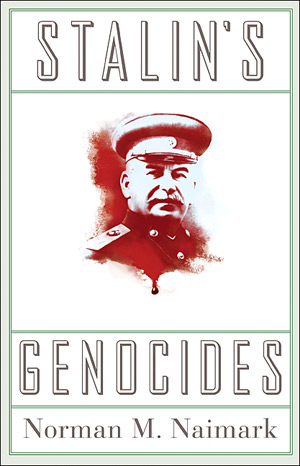
The book—really an extended essay—argues that Stalin’s mass killings in the 1930s should be classified as “genocide.”
The book suggests that the definition of genocide, as taken from the work of Raphael Lemkin and the 1948 United Nations Convention on the Prevention and Punishment of the Crime of Genocide, should be broadened to include social and political groups.
The obligation of protecting ethnic and national groups, as well as religious and racial ones, from mass murder should not obviate the need to protect political and social groups from the same horrendous crime.
In particular Stalin’s crimes should not be excluded from our consideration of genocide because the Soviet Union successfully lobbied against the inclusion of social and political groups in the Genocide Convention in the first place.
The book goes on to examine Soviet mass killing in the 1930s, demonstrating that Stalin was fully in charge of and aware of the consequences of these genocidal events. They were examples of intentional mass killing carried out by the police apparatus of the Soviet state.
Among the episodes I consider in the book are: dekulakization, the Ukrainian killer famine of 1932-33, the assault on targeted Soviet nationalities, the elimination of “asocials” or “socially harmful people” as a consequence of Order 00447, and the Great Purges.
The “rationale” for Soviet mass killing is also examined in the book, including the “war fear” argument.
“The obligation of protecting ethnic and national groups, as well as religious and racial ones, from mass murder should not obviate the need to protect political and social groups from the same horrendous crime.”
This study grew out of a long-term preoccupation with the history of genocide and the way Stalin and his crimes should be viewed in the context of that history.
More often than not, Soviet mass killing in the 1930s is left out of the our picture of the history of genocide, because its victims were Soviet citizens themselves, rather than “other” nationalities, ethnic, racial, or religious groups, though they too suffered in Stalin’s “repressions” of the 1930s.
There is an understandable reticence among both scholars and journalists to apply a term designed primarily to describe the Holocaust, the mass murder of the Jews by the Nazis, to the murder of Soviet citizens in the 1930s. Related to this issue is the problem that the 1948 United Nations Convention on the Prevention and Punishment of the Crime of Genocide looked back to the specific Nazi racial crimes of World War II as those to be punished by the international community as genocide. Social and political groups, which were included in the original drafts of the convention, were eventually excised from the genocide language primarily because of Soviet lobbying.
Academics are also sometimes reluctant to talk about Soviet mass killing of the 1930s as genocide. Part of the reason for this is the assertion that Stalin’s actions in this period had a “rational” explanation connected to external threats to the country that eventually resulted in the coming of the war. The need to modernize the Soviet Union, in this view, required Stalin to take drastic measures to prepare the country for war.
To be sure, Stalin used “war scare” propaganda to justify his murderous actions. But I argue that external threats were magnified way out of proportion to the actual danger to the Soviet Union; in fact Stalin drastically weakened the ability of the country to face the real threat of Hitler’s aggression.
In this context, the book examines explicitly the similarities of Stalin’s crimes with those of Hitler. Communist-inspired genocide, in short, should be part of our understanding of the historical phenomenon of mass murder.
I have also been fascinated by the new archival materials that have been brought to light about Stalin himself—his biography, his mentality, and his willingness to use mass killing to achieve his aims. Newly published documents from the Soviet party and Central Committee archives provide us with interesting insights into his character and the methods that Stalin used to seize control of the party and impose his will on his comrades. The book includes a chapter on “The Making of a Genocidaire.”
Some of the newest and most interesting material in the book illuminates the issue of Stalin’s use of the “special settlements” to punish his alleged opponents and to eliminate groups of Soviet citizens from the “body politic.”
Special settlement were a little-known part of the Gulag, the punitive system of works camps and places of exile set up all over the Soviet North, Siberia, and parts of Central Asia. This is where most of the so-called “kulaks,” supposedly rich peasants, were sent into exile.
The victims of Order no. 00447 who were not shot right away were also sent to these camps, to languish without food, shelter, or medical care, and often to die in abysmal conditions.
Too often these camps and others in the Gulag, like the notorious camps of Kolyma, are considered simply another form of prison life.
But the sheer barbarism of these camps—the widespread cannibalism and the inhuman treatment of men, women, and children—is an important dimension of the story of Stalin’s genocides.
“Soviet mass killing in the 1930s were examples of intentional mass killing.”
Since the fall of the Soviet Union and the opening of some materials on Stalin’s life, there has been an ongoing reevaluation of Stalin’s role in the history of the Soviet Union—indeed of his role in the history of the modern world. This process of reevaluation has special importance for the present and future of the Russian Federation.
Even the President of Russia, Dmitri Medvedev, has called for an end to making excuses for Stalin’s mass killing of Soviet citizens. It is my hope that this book will contribute in a small way to sharpening our vision of Stalin’s crimes, and putting them into the larger context of the history of genocide in the 20th Century.


Norman M. Naimark is Robert and Florence McDonnell Professor of East European Studies in the History Department of Stanford University. He is also Senior Fellow of the Hoover Institution and the Freeman-Spogli Institute for International Studies. He came to Stanford 1988 after sixteen years as Professor of History at Boston University and Research Fellow of the Russian Research Center at Harvard. Besides Stalin’s Genocides, featured in his Rorotoko interview, Naimark is the author of The Russians in Germany (Harvard 1995) and Fires of Hatred (Harvard 2001), among other books. Most recently, he has co-edited The Lost Politburo Transcripts (Yale 2009) and A Question of Genocide (Oxford forthcoming).